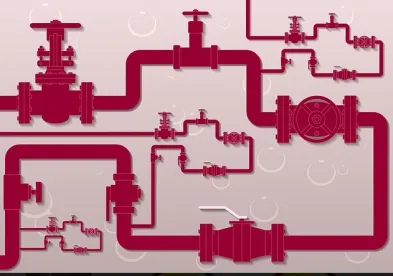PHMSA Issues Final Rule Addressing Plastic Pipe
On November 20, the Pipeline and Hazardous Materials Safety Administration (PHMSA) published a final rule amending the pipeline safety regulations applicable to the use of plastic pipe in the transportation of gas. The amended regulations apply to new, repaired, and replaced plastic pipe and will become effective January 22, 2019. Below is an overview of the amendments to the regulations.
-
Traceability and tracking provisions delayed: PHMSA delayed adopting proposed definitions of “traceability information” and “tracking information” and the proposed requirements that operators implement the tracking and traceability provisions of industry standard ASTM F2897-11a and retain tracking and traceability records for the life of the pipeline. PHMSA explained that the incorporation of the 2012 editions of material standards for polyethylene (PE) pipe and PA-12 pipe, which require that operators mark plastic pipe with the 16 character ASTM F2897-11a markings, will promote standardization of how component attributes are marked and captured in asset management systems. PHMSA will, however, require that markings be legible until the time of installation.
-
Increased design factor of PE pipe: The final rule increases the allowable design factor for new and replaced PE pipe from 0.32 to 0.40, subject to limiting the minimum wall thickness for 0.40 design factor pipe to 0.090 inches. The higher design factor also will apply to pipe sizes less than one-inch Iron Pipe Size and Copper Tubing Size.
-
Expanded use of Polyamide-11 (PA-11) pipe: The design factor for new and replaced PA-11 pipe is increased to 0.40. In addition, the maximum operating pressure is increased from 200 psig to 250 psig and the maximum pipe diameter is increased to 6-inches. Similar to PE pipe, the increased design factor for PA-11 pipe also applies to smaller diameter pipe. PHMSA is incorporating by reference ASTM F2945-12a, an industry standard for PA-11 pipe, and other modern industry standards for PA-11 and PA-12.
-
Permitted use of Polyamide-12 (PA-12) pipe: Operators are permitted to install PA-12 pipe for the first time and to use a design factor of 0.40. PA-12 pipe may be used at pressures up to 250 psig and for pipe up to 6 inches in diameter. PHMSA is incorporating by reference ASTM F2785-12 which defines material properties, manufacturing tolerances, test methods and requirements, marking requirements, and minimum quality control program requirements for PA-12 pipe, and ASTM F2767-12 which sets forth specifications for electrofusion fittings on PA-12 systems.
-
Design and construction of risers: The final rule adds new requirements for the design and construction of plastic risers, and incorporates by reference ASTM F1973, an industry standard for plastic pipe risers. PHMSA retained the requirement that risers be rigid, but removed the requirement for a 3-foot horizontal base leg. PHMSA also clarified that operators may install field-assembled anodeless risers.
-
Fittings: PHMSA is incorporating a requirement to use “Category One” joints, as defined by a listed specification. A Category One joint provides resistance to lateral forces so that a large force on the connection would cause the pipe to yield before the joint. PHMSA also adopted revised cathodic protection requirements for newly installed electrically isolated metal fittings.
-
Plastic pipe installation: The final rule adopts new requirements for a number of installation processes, including: installation via trenchless excavation, pipe joining, qualifying joining procedures, qualifying individuals to perform joints, procedures for bends and elbows, service line connections to mains, and pipe joining equipment maintenance. PHMSA did not adopt proposed repair criteria and plans to revisit this issue in a future rulemaking. PHMSA also will prohibit mechanical leak repair clamps as a permanent repair.
-
Other Amendments: The final rule permits the use of PVC pipe, adopts a variety of modern industry standards, and revises regulations related to storage and handling, component design, valve design, standard fittings, and pipe testing. PHMSA clarified that Type B regulated onshore gathering lines constructed with plastic pipe must comply with the regulations for plastic pipe. The final rule does not adopt proposed repair criteria and enhanced backfill requirements.
PHMSA Seeks Comments on FAQ Guidance for Obtaining Extensions of 7-Year Integrity Management Reassessment Interval
On November 15, PHMSA issued a Request for Comments on draft Frequently Asked Questions (FAQs) that PHMSA developed to provide guidance on what constitutes sufficient justification for obtaining a 6-month extension of the 7-year interval for performing reassessments under the gas transmission integrity management regulations. The guidance will implement authority granted by Congress in Section 5(e) of the Pipeline Safety, Regulatory Certainty, and Job Creation Act of 2011. Comments are due December 17.
PHMSA Rulemakings Update. The tables below summarize the status of the PHMSA’s pending pipeline safety rulemaking initiatives as reflected in the Department of Transportation’s (DOT) November Significant Rulemaking Report and the Office of Management & Budget’s (OMB) Office of Information and Regulatory Affairs (OIRA) Fall 2018 Unified Agenda of Regulatory and Deregulatory Actions. The Unified Regulatory Agenda appears in two principal parts, Current Agenda Agency Regulatory Entries for Active Actions and Current Long Term Actions. In addition, PHMSA has recently updated its Chart of PHMSA Regulations, required by the 2016 Protecting Our Infrastructure of Pipelines and Enhancing Safety (PIPES) Act.
Pending Final Rules
|
Proceeding |
DOT Estimated Publication |
OIRA Estimated Publication |
PHMSA's 2016 PIPES Act Chart |
|
Enhanced Emergency Order Procedures |
December 7, 2018 |
October 2018 |
December 24, 2018 |
|
Plastic Pipe Rule |
Issued November 20, 2018 |
||
|
Safety of Gas Transmission Pipelines, MAOP Reconfirmation, Expansion of Assessment Requirements and Other Related Amendments |
April 4, 2019 |
March 2019 |
March 14, 2019 |
|
Safety of Gas Transmission Pipelines, Repair Criteria, Integrity Management Improvements, Cathodic Protection, Management of Change, and Other Related Amendments |
December 20, 2019 |
December 2019 |
Not Listed |
|
Safety of Gas Gathering Pipelines |
December 20, 2019 |
December 2019 |
Not Listed |
|
Safety of Onshore Hazardous Liquid Pipelines |
March 15, 2019 |
December 2018 |
January 7, 2019 |
|
Underground Natural Gas Storage Facilities |
January 21, 2019 |
December 2018 |
January 21, 2019 |
Pending Notices of Proposed Rulemakings
|
Proceeding |
DOT Estimated Publication |
OIRA Estimated Publication |
PHMSA's 2016 PIPES Act Chart |
|
Class Location Requirements |
Not Provided |
September 2019 |
Not Listed |
|
Gas Pipeline Regulatory Reform |
May 10, 2019 |
May 2019 |
Not Listed |
|
Liquid Pipeline Regulatory Reform |
Not Listed |
February 2019 |
Not Listed |
|
Periodic Standards Update |
Not Listed |
April 2020 |
Not Listed |
|
Repair Criteria for Hazardous Liquid Pipelines |
Not Listed |
Next Action Undetermined |
Not Listed |
|
Valve Installation and Minimum Rupture Detection Standards |
March 29, 2019 |
January 2019 |
January 14, 2019 |
Pending Advanced Notices of Proposed Rulemakings
|
Proceeding |
DOT Estimated Publication |
OIRA Estimated Publication |
|
Coastal Ecological Unusually Sensitive Areas |
Not Listed |
April 2020 |
OTHER PHMSA UPDATES
DOT increases maximum civil penalties under the Pipeline Safety Act. On November 27, DOT issued a final rule increasing the civil penalties that PHMSA may assess under section 60122 of the Pipeline Safety Act. The maximum civil penalty for each pipeline safety violation increased from $209,002 to $213,268, and the maximum penalty for a related series of pipeline safety violations increased from $2,090,022 to $2,132,679. The maximum penalty for liquefied natural gas pipeline safety violations increased from $76,352 to $77,910. These increases account for inflation.
The random drug testing rate remains at 50 percent for 2019. On December 11, PHMSA issued a Notice that the minimum random drug testing rate for covered employees will remain at 50% during calendar year 2019. The notice reminds operators with 50 or more employees to submit their annual Drug and Alcohol Management Information System (DAMIS) reports containing drug and alcohol testing information for employees and contractors performing (or ready to perform) covered functions. DAMIS user names and passwords will be available via the PHMSA Portal in January 2019.
PHMSA Voluntary Information Sharing Working Group to meet on December 18-19. On November 27, PHMSA issued a notice that the Voluntary Information-Sharing (VIS) Working Group will meet on December 18-19 in Washington D.C. to continue discussions regarding establishment of a voluntary information-sharing system. Information on this meeting and previous meetings is here.
DOT’s Office of Inspector General (OIG) announces audit of PHMSA’s oversight of LNG facilities. On October 16, DOT’s OIG announced that it has initiated an audit of PHMSA’s oversight of LNG facility operators’ compliance with Part 193 safety regulations which address the siting, design, construction, operation, and security of LNG facilities. PHMSA also oversees 151 LNG plants in conjunction with state pipeline safety offices. Noting that PHMSA’s LNG oversight responsibilities may increase as U.S. LNG exports are projected to increase and that PHMSA’s oversight will need to be effective and efficient, OIG states that it will assess PHMSA’s oversight of LNG operators’ compliance with federal regulations and states that conduct inspections of LNG facilities.
UPDATES FROM OTHER FEDERAL AGENCIES
TSA seeks comment regarding extension of information collection request involving pipeline security information. On October 29, the Transportation Security Administration (TSA) issued a Notice requesting public comment on a proposed extension of a currently approved information collection request under which pipelines are encouraged to notify the Transportation Security Operations Center of incidents that may indicate a deliberate attempt to disrupt pipeline operations and activities that could be precursors to such an attempt. Notifications are provided to TSA pursuant to the Pipeline Security Guidelines. Comments are due December 28.
UPDATES FROM INDUSTRY
AGA releases report on leading practices to reduce over-pressurization events. On November 26, the American Gas Association (AGA) released a report entitled “Leading Practices to Reduce the Possibility of a Natural Gas Over-Pressurization Event.” The document provides guidance to natural gas utilities identifying practices that exceed regulatory requirements that may, depending on the unique characteristics of each operator’s system, help to reduce over-pressurization events.
Northeast Gas Association seeks consulting assistance implementing pipeline safety management systems. On November 26, the Northeast Gas Association (NGA) issued a request for proposals (RFP) seeking a consultant to develop a framework to guide NGA members in consistently implementing pipeline safety management systems, in particular, the approach described in American Petroleum Institute (API) Recommended Practice (RP) 1173. Proposals are due January 11, 2019.






 />i
/>i

